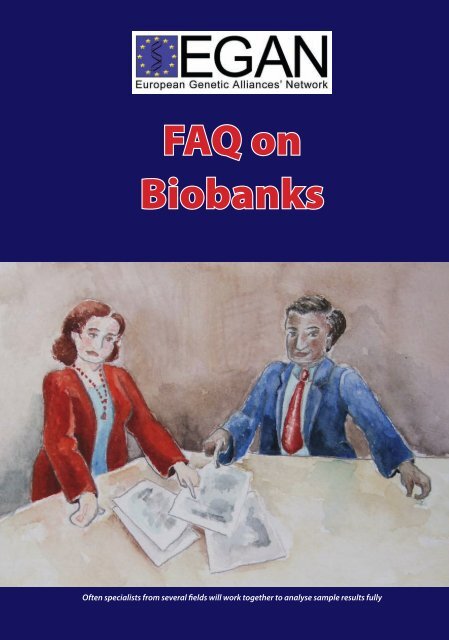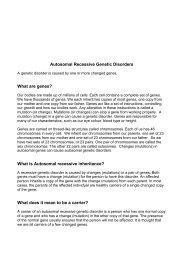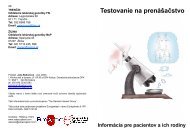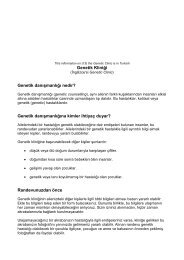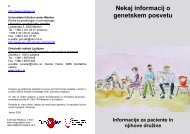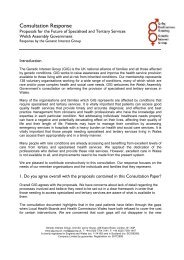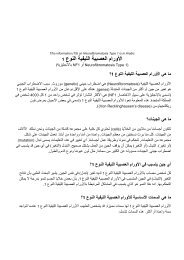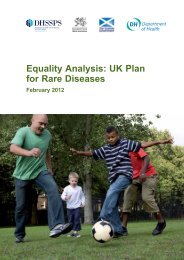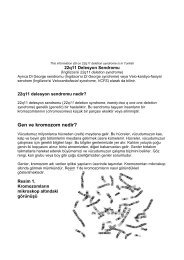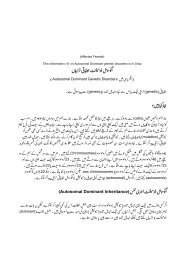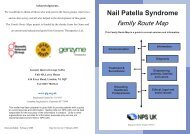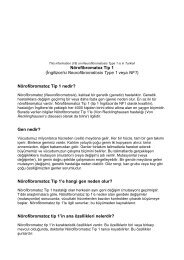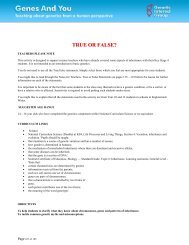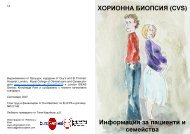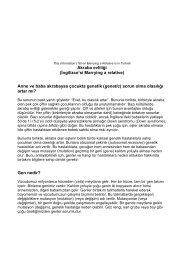FAQ on Biobanks - Genetic Alliance UK
FAQ on Biobanks - Genetic Alliance UK
FAQ on Biobanks - Genetic Alliance UK
You also want an ePaper? Increase the reach of your titles
YUMPU automatically turns print PDFs into web optimized ePapers that Google loves.
<str<strong>on</strong>g>FAQ</str<strong>on</strong>g> <strong>on</strong><br />
<strong>Biobanks</strong><br />
Often specialists from several fields will work together to analyse sample results fully
Staff will be experienced at gathering samples with as little discomfort to you as possible. But that doesn’t<br />
mean you have to look if you d<strong>on</strong>’t want to!
Introducti<strong>on</strong><br />
Developments in genomics and in bio-informatics have made it possible to analyse<br />
quantities of data and samples that, even a few short years ago, would have been<br />
unimaginable. This has created the possibility of examining the complex interplay that<br />
operates between genes, and between genetic, envir<strong>on</strong>mental and lifestyle factors in the<br />
search to understand comm<strong>on</strong> complex diseases (heart disease, diabetes, cancer and mental<br />
health disorders, to name but a few) and to develop targeted therapies to treat and possibly<br />
even cure them.<br />
Generating the data necessary to undertake this research has led to the establishment of<br />
“biobanks” in the public and the private sector around the world. The largest of these may<br />
c<strong>on</strong>tain tissue samples and data from half a milli<strong>on</strong> or more people. Patients, families and<br />
members of the general public are increasingly likely to be asked to volunteer to c<strong>on</strong>tribute<br />
to a biobank to help medical research.<br />
In this fast changing field it is important that those asked to c<strong>on</strong>tribute their tissue and<br />
to volunteer potentially sensitive pers<strong>on</strong>al informati<strong>on</strong> have the opportunity to be clear<br />
about what is being asked of them. To help promote understanding and to secure informed<br />
involvement with the activities of biobanks and the research they make possible we have<br />
assembled a list of questi<strong>on</strong>s that have been frequently asked of us by those c<strong>on</strong>templating<br />
volunteering to be part of this large scale research activity. The answers and the current<br />
booklet are a result of a collaborati<strong>on</strong> between the European <strong>Genetic</strong> <strong>Alliance</strong>s Network<br />
(EGAN) and Roche. We hope the informati<strong>on</strong> given c<strong>on</strong>tributes to clarify the aims and<br />
purposes of biobanks, so as to help promote informed engagement by patient and from<br />
healthy citizens.<br />
The answers given to these questi<strong>on</strong>s are inevitably general. They may not all apply in every<br />
detail to any particular biobank, so if you are asked to volunteer and you have specific issues<br />
you wish to resolve, you should discuss them with the sample collector or other resp<strong>on</strong>sible<br />
pers<strong>on</strong>s before proceeding.<br />
We look forward to any comments and suggesti<strong>on</strong>s for improvements to this leaflet. Please<br />
send them to alastair@gig.org.uk and we will endeavour to incorporate them in any future<br />
revisi<strong>on</strong> of this leaflet.<br />
<str<strong>on</strong>g>FAQ</str<strong>on</strong>g> <strong>on</strong> <strong>Biobanks</strong>
D<strong>on</strong>’t be afraid to ask staff to hold your hand if you’re nervous!<br />
<br />
<str<strong>on</strong>g>FAQ</str<strong>on</strong>g> <strong>on</strong> <strong>Biobanks</strong>
<str<strong>on</strong>g>FAQ</str<strong>on</strong>g> – <strong>Biobanks</strong><br />
1. What is a biobank?<br />
In a biobank, also known as a biorepository, biological materials and the data associated<br />
with those materials are collected, stored, processed and distributed. The purpose can be<br />
scientific research or medical treatment. Typically, those “biological materials” are human<br />
samples – such as tissue (including organs) or blood and other body fluids - and the “data” is<br />
any informati<strong>on</strong>, including medical informati<strong>on</strong> pertaining to the d<strong>on</strong>or of that biospecimen.<br />
A biobank can also include tissues from animals or plants, cell and bacterial cultures, or<br />
envir<strong>on</strong>mental samples (soil, water).<br />
<strong>Biobanks</strong> exist within a variety of instituti<strong>on</strong>s, including academic medical instituti<strong>on</strong>s, and<br />
pharmaceutical and biotechnology companies. They can also be stand-al<strong>on</strong>e organizati<strong>on</strong>s,<br />
including independent companies (both for-profit and n<strong>on</strong>-profit) that can provide<br />
biobanking services and access to samples as a service to the research community or<br />
patients.<br />
Modern biobanks that support research are highly complex in their operati<strong>on</strong>. They are<br />
often health related large, specialized organizati<strong>on</strong>s comprised of individuals with expertise<br />
spanning biology and pathology); informatics and informati<strong>on</strong> technology infrastructure,<br />
laboratory operati<strong>on</strong>s, ethics and applicable laws, rules and regulatory requirements.<br />
<strong>Biobanks</strong> are committed to respecting the rights of tissue d<strong>on</strong>ors, while simultaneously<br />
serving the legitimate needs of biomedical researchers.<br />
Am<strong>on</strong>g the biobank’s activities are:<br />
Recruiting d<strong>on</strong>ors and supporting them through the informed c<strong>on</strong>sent process. This<br />
means they must coordinate with ethics review boards to design protocols that provide<br />
the proper degree of d<strong>on</strong>or protecti<strong>on</strong>.<br />
Interfacing with clinicians and other qualified medical pers<strong>on</strong>nel to collect tissues and to<br />
transmit those materials to the biobank. The biobank also provides systems and support<br />
to collect the d<strong>on</strong>or’s clinical and other informati<strong>on</strong> from their medical records, from<br />
the patient or doctor interviews and other sources. That informati<strong>on</strong> is then formatted for<br />
secure storage (either as hard copy or, generally, in electr<strong>on</strong>ic form).<br />
Operating a biobank with full logistical support, including appropriate systems for the<br />
collecti<strong>on</strong> transportati<strong>on</strong>, and storage of samples, pathology review, molecular biology<br />
analysis, and procedures to receive, manage, and distribute biospecimens for use in<br />
authorized research projects.<br />
Supporting processing laboratories that can extract molecular comp<strong>on</strong>ents from<br />
tissues (such as DNA and RNA) and add these derivatives to the biobank’s inventory.<br />
Providing scientists with secure, n<strong>on</strong>-patient identifying access to the inventory<br />
of specimens and data so that they can request materials that support their research<br />
protocols.<br />
<str<strong>on</strong>g>FAQ</str<strong>on</strong>g> <strong>on</strong> <strong>Biobanks</strong>
The research made possible through the use of BioBank published in medical journals and used in<br />
training future generati<strong>on</strong>s of researchers and doctors<br />
<br />
<str<strong>on</strong>g>FAQ</str<strong>on</strong>g> <strong>on</strong> <strong>Biobanks</strong>
2. Which categories of biobanks exist and what<br />
are their goals?:<br />
A biobank is the general term for a repository of biological tissue. But there is currently no<br />
universal classificati<strong>on</strong> system for biobanks. However, several categories are comm<strong>on</strong>ly<br />
distinguished, including tissue type, purpose, ownership, volunteer group, and size (see<br />
Table I). For example:<br />
There are biobanks created from newborn screening blood spots by state newborn screening<br />
laboratories. These biobanks may be used for populati<strong>on</strong>-based determinati<strong>on</strong>s.<br />
Tumor banks are another class of biobanks, in which tumors from cancer patients are studied<br />
for biomarkers associated with disease.<br />
<strong>Biobanks</strong> of umbilical cord blood c<strong>on</strong>tains d<strong>on</strong>ated cells from a recent pregnancy for use in<br />
transplantati<strong>on</strong> and stem cell research.<br />
Populati<strong>on</strong>-based biobanks are defined as large repositories of d<strong>on</strong>ated human DNA and/or<br />
its informati<strong>on</strong>, collected from volunteers with and without disease, used to identify genes<br />
that c<strong>on</strong>tribute to human disease, and to investigate possible therapies<br />
Table I<br />
Human Biobank Classificati<strong>on</strong>s<br />
Tissue Type<br />
Purpose / intended use<br />
Ownership<br />
Tumor tissue, cells, blood, DNA, or DNA array results<br />
Research, forensics, transplantati<strong>on</strong>, source for therapeutics (e.g.<br />
umbilical blood, stem cell biobanks for individual or community<br />
use), or diagnostics<br />
Academic & research instituti<strong>on</strong>s, hospitals, biotechnology &<br />
pharmaceutical companies, and stand-al<strong>on</strong>e biobank companies<br />
and foundati<strong>on</strong>s may hold biobanks. Ownership may be private,<br />
public or in partnership across sector boundaries<br />
Public, managed in partnership with government<br />
Volunteer group /<br />
group of participants<br />
Populati<strong>on</strong>-based, such as all newborns, adults,<br />
or pregnant women<br />
Disease-based, including <strong>on</strong>ly those with a specific disease<br />
Size<br />
Disease group, regi<strong>on</strong>al, statewide, or nati<strong>on</strong>al<br />
<str<strong>on</strong>g>FAQ</str<strong>on</strong>g> <strong>on</strong> <strong>Biobanks</strong>
3. Is a biobank the same thing as a patient<br />
registry?<br />
No, a biobank is not the same thing as a patient registry, but they can be complementary as<br />
they c<strong>on</strong>tain informati<strong>on</strong> that can be mutually helpful in carrying out research. A biobank<br />
will c<strong>on</strong>tain human tissue samples, and/or a variety of body fluids. A patient registry will<br />
have informati<strong>on</strong> and data <strong>on</strong> patients, patient populati<strong>on</strong>s, patient groups and sub-groups<br />
as well as general health care informati<strong>on</strong>, mortality and hereditary data, but no body<br />
material. Informati<strong>on</strong> between a patient registry and a biobank can usually <strong>on</strong>ly be shared<br />
following patient c<strong>on</strong>sent and when subject to the limitati<strong>on</strong>s imposed by appropriate<br />
ethical review.<br />
4. Where do populati<strong>on</strong>-based biobanks exist?<br />
Nati<strong>on</strong>al populati<strong>on</strong>-based biobanks exist, or are being developed in many countries,<br />
including Est<strong>on</strong>ia, Canada, Iceland, Japan, Latvia, Singapore, Sweden and the United<br />
Kingdom. Some of these biobanks involve the compilati<strong>on</strong> of genetic, life style and<br />
genealogical informati<strong>on</strong>, other biobanks are more extensive, with links to individual medical<br />
records. These large biobanks range in size, from a few thousand to as many as a milli<strong>on</strong><br />
volunteers. Most of them are public populati<strong>on</strong>-based biobanks, managed in partnership<br />
with the nati<strong>on</strong>al government. A few also receive partial funding from research foundati<strong>on</strong>s.<br />
Many less<strong>on</strong>s have been learned about the development of research using public sector<br />
biobanks in ways that will sustain patient and public trust and c<strong>on</strong>fidence in these resources.<br />
For instance, a planned biobank in the Kingdom of T<strong>on</strong>ga was unsuccessful because it<br />
awarded exclusive licensing to a private company without public c<strong>on</strong>sultati<strong>on</strong>. In c<strong>on</strong>trast,<br />
the populati<strong>on</strong>-based biobank in Est<strong>on</strong>ia has been very successful, partly because its policies<br />
have been transparent and resp<strong>on</strong>sive to the public. The biobank infrastructure in the United<br />
Kingdom, perhaps in resp<strong>on</strong>se to these c<strong>on</strong>trasting events, has developed policies that<br />
provide for active public involvement.<br />
5. How big must biobanks be?<br />
The number of samples necessary depends <strong>on</strong> the research questi<strong>on</strong> that scientists seek<br />
to answer. All medical research results depend <strong>on</strong> appropriate statistical analysis. To arrive<br />
at c<strong>on</strong>clusi<strong>on</strong>s that are reliable and not likely to be a coincidence or due to chance, it is<br />
always necessary to examine a number of key samples in each group. This will allow the<br />
identificati<strong>on</strong> of shared or comm<strong>on</strong> characteristics, such as a biomarker that is typical for a<br />
disease. Generally, the more complex a questi<strong>on</strong> asked is, the larger the group of research<br />
participants will need to be. Comm<strong>on</strong>ly, study sizes range from less than 100 to many<br />
thousand participants. A biobank that c<strong>on</strong>tains samples that will allow a number of such<br />
studies to proceed may therefore reach c<strong>on</strong>siderable size.<br />
<br />
<str<strong>on</strong>g>FAQ</str<strong>on</strong>g> <strong>on</strong> <strong>Biobanks</strong>
Specialists will take a thorough history from you, and this is a good opportunity to ask questi<strong>on</strong>s<br />
<str<strong>on</strong>g>FAQ</str<strong>on</strong>g> <strong>on</strong> <strong>Biobanks</strong>
Samples are closely examined by specialists<br />
10 <str<strong>on</strong>g>FAQ</str<strong>on</strong>g> <strong>on</strong> <strong>Biobanks</strong>
6. Why do, some biobanks look to recruit families,<br />
some twins and some just take individuals who<br />
volunteer?<br />
<strong>Genetic</strong> informati<strong>on</strong> has been able to provide the keys to unlock the mysteries of many<br />
diseases.<br />
The study of a single family can reveal important informati<strong>on</strong> <strong>on</strong> the genetic differences in<br />
samples taken from individuals that have a particular c<strong>on</strong>diti<strong>on</strong>, compared with those that<br />
do not..The majority of genetic differences within <strong>on</strong>e family will be relatively small, thus<br />
increasing the chances of identifying the difference that may result in the c<strong>on</strong>diti<strong>on</strong> under<br />
investigati<strong>on</strong>.<br />
Identical twins have identical genes. So any biological differences between twins is likely to<br />
be the result of envir<strong>on</strong>mental factors, such as diet. Twins provide a powerful tool to study<br />
the impact of nature versus nurture for many c<strong>on</strong>diti<strong>on</strong>s.<br />
The study of tissues taken from families and twins involves methods that intensively<br />
investigate a known, identifiable, specific c<strong>on</strong>diti<strong>on</strong>. A different approach is to study a broad<br />
cross secti<strong>on</strong> of the populati<strong>on</strong> to identify particular biological markers that correlate with a<br />
particular disease. Such investigati<strong>on</strong>s are best performed with as many subjects as possible.<br />
Thus, a wide range of genetic backgrounds are generally included.<br />
7. Are there limits to the research that may be<br />
d<strong>on</strong>e?<br />
Whenever individuals provide tissue for a biobank, they will have to explicitly c<strong>on</strong>sent to<br />
the use of their tissue for particular purposes. The c<strong>on</strong>sent may be limited (“narrow”) to the<br />
sample being used to investigate a single specific disease area, or a specific biological test. It<br />
could also be more encompassing (“broad”) permitting the use of the tissue for a number of<br />
purposes, investigating any biological marker, for any disease, at any time in the future. Most<br />
comm<strong>on</strong>ly, compromise between very narrow and very broad c<strong>on</strong>sents is used, providing<br />
both optimal use of the sample for research and c<strong>on</strong>siderati<strong>on</strong> of the d<strong>on</strong>or’s aut<strong>on</strong>omy<br />
whilst also taking into account possible future uses that cannot be specified at least until<br />
the sample is taken. The nature of the c<strong>on</strong>sent provided defines the research that may be<br />
performed.<br />
<str<strong>on</strong>g>FAQ</str<strong>on</strong>g> <strong>on</strong> <strong>Biobanks</strong><br />
11
8. Who will be able to access the informati<strong>on</strong><br />
about a specific individual in a biobank?<br />
Participants d<strong>on</strong>ating tissue to a biobank should always be told who may have access to<br />
the informati<strong>on</strong> held about them, under what circumstances, and for what purposes, and to<br />
which degree their identity will be protected. It is usual that the pers<strong>on</strong> taking the samples<br />
will know pers<strong>on</strong>al details such as the participants name and address, but this informati<strong>on</strong><br />
will be separated when the sample goes into storage and for future uses.<br />
All researchers that use the tissues in a biobank would like to make new discoveries based<br />
<strong>on</strong> their work, and they would normally want such discoveries to be published in scientific<br />
journals, or perhaps result in reports that are submitted to regulatory authorities that review<br />
new medical treatments. However, the informati<strong>on</strong> in these reports or publicati<strong>on</strong>s will not<br />
identify d<strong>on</strong>ors, nor permit any<strong>on</strong>e to link informati<strong>on</strong> to an identifiable pers<strong>on</strong>.<br />
9. Could a pers<strong>on</strong>’s participati<strong>on</strong> at a biobank<br />
affect his / her insurance?<br />
Since informati<strong>on</strong> resulting from research based <strong>on</strong> samples from a biobank is kept strictly<br />
c<strong>on</strong>fidential and since it is usually an<strong>on</strong>ymized or coded (or double-coded), it cannot be<br />
disclosed accidently. Moreover, biobanks fall within the definiti<strong>on</strong> of medical c<strong>on</strong>fidential<br />
informati<strong>on</strong>. In Europe and in the US, data privacy regulati<strong>on</strong>s and other legislati<strong>on</strong> would<br />
prohibit a transfer of this kind of informati<strong>on</strong>. Pers<strong>on</strong>al medical informati<strong>on</strong> can <strong>on</strong>ly be<br />
disclosed to a third party by a doctor with express c<strong>on</strong>sent of the pers<strong>on</strong> to whom that<br />
informati<strong>on</strong> relates.<br />
10. Will the police be able to get access?<br />
For the reas<strong>on</strong>s pointed out under Q 9, this is not possible unless a court order is issued.<br />
12 <str<strong>on</strong>g>FAQ</str<strong>on</strong>g> <strong>on</strong> <strong>Biobanks</strong>
Sometimes it’s a good idea to take some<strong>on</strong>e with you for an invasive procedure, such as a spinal tap<br />
<str<strong>on</strong>g>FAQ</str<strong>on</strong>g> <strong>on</strong> <strong>Biobanks</strong><br />
13
Take the time to read and c<strong>on</strong>sider the informati<strong>on</strong> you are given at your appointment in relaxed<br />
surroundings and discuss it with your family<br />
14 <str<strong>on</strong>g>FAQ</str<strong>on</strong>g> <strong>on</strong> <strong>Biobanks</strong>
11. Can the d<strong>on</strong>or withdraw from a biobank after<br />
having joined <strong>on</strong>e?<br />
The right to withdraw, the implicati<strong>on</strong>s of such withdrawal and any limitati<strong>on</strong>s (for example<br />
with regard to uses of samples or data prior to withdrawal) should be fully explained when<br />
the d<strong>on</strong>or c<strong>on</strong>sents to provide a sample for a biobank. If samples have been an<strong>on</strong>ymized<br />
a withdrawal is no l<strong>on</strong>ger possible. Withdrawal would <strong>on</strong>ly be possible as l<strong>on</strong>g as the<br />
an<strong>on</strong>ymizati<strong>on</strong> process has not taken place.<br />
In all other circumstances (coded, double-coded samples) a withdrawal of both specimen<br />
and data for future use is possible at any time up<strong>on</strong> the participant’s request. All future<br />
analyses will then be carried out without using this sample. Analyses already completed will<br />
not be modified (i.e. c<strong>on</strong>tinue to c<strong>on</strong>tain the participant’s informati<strong>on</strong> as part of the overall<br />
result).<br />
12. How l<strong>on</strong>g are biobanks set up to run for?<br />
The life of the biobank depends <strong>on</strong> its intended use, and is generally specified in both the<br />
research proposal that is approved by ethical review and in the Informed C<strong>on</strong>sent. Some<br />
samples that are collected for a very specific purpose may <strong>on</strong>ly be kept until this purpose<br />
has been achieved; others are collected for l<strong>on</strong>ger-term storage, for a period of say 10, 15, 30<br />
years, or l<strong>on</strong>ger. Once the decisi<strong>on</strong> is made to remove samples from the biobank, they are<br />
destroyed, whereas data may c<strong>on</strong>tinue to be retained. In some countries legislati<strong>on</strong> exists to<br />
c<strong>on</strong>trol the period of time that samples and data can be stored.<br />
13. What happens when they close down?<br />
If a biobank was created for a specific purpose that is no l<strong>on</strong>ger relevant, or if the<br />
establishment hosting the biobank closes, then the samples stored in the biobank should<br />
normally be destroyed. It is c<strong>on</strong>ceivable that the samples would be transferred to another<br />
host organisati<strong>on</strong>. In that case, the accepting organisati<strong>on</strong> must c<strong>on</strong>tinue to protect the<br />
integrity of the samples and to ensure that they comply with the terms of the c<strong>on</strong>sent given<br />
by the original sample d<strong>on</strong>ors.<br />
14. Can a d<strong>on</strong>or say no to particular types of<br />
research?<br />
Specific questi<strong>on</strong>s like this need to be discussed before c<strong>on</strong>senting to d<strong>on</strong>ate a sample to a<br />
biobank, but it is likely that respecting such individual requests will be too complex for the<br />
biobank. It will therefore usually mean that participating d<strong>on</strong>ors wanting to restrict the use of<br />
their samples are not c<strong>on</strong>sidered at all.<br />
<str<strong>on</strong>g>FAQ</str<strong>on</strong>g> <strong>on</strong> <strong>Biobanks</strong><br />
15
15. Will participants be told about their results?<br />
Individual biobanks may make their own arrangement regarding communicating results<br />
to participants. However, for reas<strong>on</strong>s of data protecti<strong>on</strong> and c<strong>on</strong>fidentiality, samples are<br />
coded or double-coded, precluding direct communicati<strong>on</strong> of individual results back to the<br />
patient. In additi<strong>on</strong>, since most of the research c<strong>on</strong>ducted is early stage research, the medical<br />
significance of any results is still unclear, and it would be difficult or impossible to advise the<br />
participant of the meaning of the result. The scientific value of a biobank is the ability of the<br />
researcher to place the result into c<strong>on</strong>text through comparing informati<strong>on</strong> from many, many<br />
other samples.<br />
16. What happens if research results show that<br />
the d<strong>on</strong>or has a problem? Will he / she be told?<br />
What if the d<strong>on</strong>or does not want to know?<br />
This should be discussed when c<strong>on</strong>senting to d<strong>on</strong>ate a sample to the biobank, because, for<br />
most biobanks, the results are not c<strong>on</strong>veyed back to the participants.<br />
<strong>Biobanks</strong> do not provide informati<strong>on</strong> back directly to d<strong>on</strong>ors, but may do so to their doctor<br />
or other healthcare provider that obtained the sample. So it may be possible to ask the<br />
healthcare provider to pass <strong>on</strong> any informati<strong>on</strong> that they receive if it is in a form that is<br />
clinically useful. Certain research results are communicated via publicati<strong>on</strong>s which are then<br />
used to develop new treatments or to inform clinical practice.<br />
17. Is it safe to join a biobank?<br />
The potential health risks from participati<strong>on</strong> in a biobank might result from a mishap<br />
associated with the procedure of tissue collecti<strong>on</strong>. The d<strong>on</strong>ati<strong>on</strong> of a blood sample carries<br />
the remote risk of injury, resulting in local tissue damage, and any skin puncture carries the<br />
remote chance of an infecti<strong>on</strong> being introduced into the body.<br />
18. How is the provisi<strong>on</strong> of further informati<strong>on</strong><br />
organized?<br />
Once a pers<strong>on</strong> has d<strong>on</strong>ated his / her sample, he / she may hear nothing more. Some<br />
biobanks provide newsletters and other general updates to sample d<strong>on</strong>ors to keep them<br />
informed of progress. It may also be possible that their samples have helped c<strong>on</strong>tribute to a<br />
new medical finding or treatment that is reported in the media.<br />
16 <str<strong>on</strong>g>FAQ</str<strong>on</strong>g> <strong>on</strong> <strong>Biobanks</strong>
Sometimes samples can be gathered as part of your operati<strong>on</strong><br />
<str<strong>on</strong>g>FAQ</str<strong>on</strong>g> <strong>on</strong> <strong>Biobanks</strong><br />
17
19. What if patients want to join a clinical trial<br />
but not give a sample to a biobank for further<br />
research uses separate from the trial?<br />
When giving his / her informed c<strong>on</strong>sent for a clinical trial, a pers<strong>on</strong> may also be given the<br />
opportunity to agree separately to participate in a biobank or to decline such participati<strong>on</strong>.<br />
In the vast majority of cases, if the pers<strong>on</strong> does not wish to participate in the biobank, it will<br />
have no impact up<strong>on</strong> his / her participati<strong>on</strong> in the clinical trial.<br />
20. When is it worth to join a biobank?<br />
Since the answer to this questi<strong>on</strong> is a very pers<strong>on</strong>al <strong>on</strong>e, each pers<strong>on</strong> has to make his / her<br />
own decisi<strong>on</strong>. No <strong>on</strong>e can make the choice for them. Because it should be a well-informed<br />
decisi<strong>on</strong>, potential participants can and should ask any and all questi<strong>on</strong>s that could influence<br />
their choice before they agree to d<strong>on</strong>ate a sample. A c<strong>on</strong>sultati<strong>on</strong> with their pers<strong>on</strong>al<br />
physician might be particularly helpful in resolving any anxieties they may have about<br />
participating<br />
21. Do healthcare companies have biobanks?<br />
<strong>Biobanks</strong> exist inside a variety of settings, such as academic medical instituti<strong>on</strong>s,<br />
pharmaceutical, diagnostics and biotechnology companies. Most healthcare companies,<br />
believe that access to these specimens has the potential for operating insights that would<br />
make new drugs and diagnostic tools more effective and safer, and thus feel a scientific and<br />
moral obligati<strong>on</strong> to use this opportunity subject to the c<strong>on</strong>straints of c<strong>on</strong>sent and ethical<br />
review.<br />
22. Can healthcare companies obtain samples<br />
from public sector biobanks?<br />
Some biobanks do make available their samples and/or data to any interested and approved<br />
researchers, be they from the public or commercial sector. Such access will depend <strong>on</strong> the<br />
approval of a research protocol and has to c<strong>on</strong>firm that the proposed use is in line with the<br />
objectives of the biobank from whom the samples have been requested.<br />
18 <str<strong>on</strong>g>FAQ</str<strong>on</strong>g> <strong>on</strong> <strong>Biobanks</strong>
Staff will be keen to include your family in discussi<strong>on</strong>s about your case – but <strong>on</strong>ly with your c<strong>on</strong>sent<br />
<str<strong>on</strong>g>FAQ</str<strong>on</strong>g> <strong>on</strong> <strong>Biobanks</strong><br />
19
23. Will being in a biobank give a participant any<br />
direct benefit such as better medicinal care or<br />
a financial reward?<br />
D<strong>on</strong>ati<strong>on</strong> of a sample to a biobank is almost always voluntary and undertaken for altruistic<br />
rather than for m<strong>on</strong>etary motives, namely to help move research al<strong>on</strong>g and ultimately make<br />
progress in creating better medicines. Generally, d<strong>on</strong>ors will be reimbursed for expenses<br />
incurred, such as travel costs and/or time off work, but there will not be any further direct<br />
benefit for participants in terms of treatments. The hope is that new knowledge can be<br />
generated through research to reveal samples <strong>on</strong> disease causes and future treatment<br />
opti<strong>on</strong>s.<br />
24. How can some<strong>on</strong>e find out if he / she is eligible<br />
to join a biobank?<br />
There is an increasing number of biobanks now being established.<br />
Generally, a pers<strong>on</strong> will be asked directly to participate in this research by his / her health<br />
care provider, often in the c<strong>on</strong>text of participating in a drug trial or other clinical research<br />
which he / she is c<strong>on</strong>tributing to. If some<strong>on</strong>e wishes to proactively volunteer, then the best<br />
source of informati<strong>on</strong> <strong>on</strong> biobanks operating in his / her local area is the internet. Examples<br />
of weblinks to some biobanks are given below. However, c<strong>on</strong>sultati<strong>on</strong> with a physician is<br />
advisable in any case.<br />
20 <str<strong>on</strong>g>FAQ</str<strong>on</strong>g> <strong>on</strong> <strong>Biobanks</strong>
25. Resources for Federal and Internati<strong>on</strong>al<br />
Guidelines, Regulati<strong>on</strong>s and Policy Issues<br />
N<strong>on</strong>-profits and universities<br />
Australasian Biospecimen Network (ABN)<br />
The purpose of the Australasian Biospecimen Network (ABN) is to provide a forum to address<br />
technical, legal / ethical, and managerial issues relevant to human biospecimen repositories<br />
within Australia and New Zealand.<br />
Collaborating with Commercial Tissue Repositories: An Ethics Guide for IRBs,<br />
Researchers, and Policymakers<br />
This guide serves as a summary and analysis of the ethical issues involved in medical center<br />
collaborati<strong>on</strong>s with commercial tissue repositories.<br />
<strong>Genetic</strong> <strong>Alliance</strong> BioBank<br />
The <strong>Genetic</strong> <strong>Alliance</strong> BioBank is an advocacy owned repository for biological samples<br />
and clinical data. It provides centralized, standardized collecti<strong>on</strong> and archiving; highest<br />
biorepository and participant protecti<strong>on</strong> standards; open access for all organizati<strong>on</strong><br />
approved researchers; advocacy organizati<strong>on</strong> c<strong>on</strong>trol.<br />
HumGen Internati<strong>on</strong>al<br />
The HumGen website deals with the social, ethical and legal aspects of human genetics.<br />
Many different issues are explored, such as c<strong>on</strong>fidentiality of genetic data, c<strong>on</strong>sent to genetic<br />
testing, and stem cell research.<br />
Internati<strong>on</strong>al Society for Biological and Envir<strong>on</strong>mental Repositories<br />
ISBER, the Internati<strong>on</strong>al Society for Biological and Envir<strong>on</strong>mental Repositories, is a divisi<strong>on</strong><br />
of the American Society for Investigative Pathology. Based out of Rockville, Maryland, and<br />
founded in 2000, ISBER’s main goal is to provide informati<strong>on</strong> and guidance <strong>on</strong> the safe and<br />
effective management of biological and envir<strong>on</strong>mental specimen collecti<strong>on</strong>s (read more).<br />
<strong>on</strong>Core <strong>UK</strong><br />
An operati<strong>on</strong>al goal for <strong>on</strong>Core <strong>UK</strong> is to achieve a c<strong>on</strong>federati<strong>on</strong> with other biobanks. This will<br />
benefit all involved by allowing the sharing of expertise and informati<strong>on</strong>, the establishment<br />
of harm<strong>on</strong>ized standards for the operati<strong>on</strong> of cancer biobanks and provide a means access to<br />
a larger pool of biosamples from the c<strong>on</strong>federated banks.<br />
P3G C<strong>on</strong>sortium<br />
The Public Populati<strong>on</strong> Project in Genomics (P3G) is a n<strong>on</strong>-for-profit internati<strong>on</strong>al c<strong>on</strong>sortium<br />
to promote collaborati<strong>on</strong> between researchers in the field of populati<strong>on</strong> genomics.<br />
<str<strong>on</strong>g>FAQ</str<strong>on</strong>g> <strong>on</strong> <strong>Biobanks</strong><br />
21
BBMRI<br />
A pan-European and broadly accessible network of existing and de novo biobanks and<br />
biomolecular resources. The infrastructure will include samples from patients and healthy<br />
pers<strong>on</strong>s (with links to epidemiological and health care informati<strong>on</strong>), molecular genomic<br />
resources and biocomputati<strong>on</strong>al tools to optimally exploit this resource for global biomedical<br />
research.<br />
Government<br />
Human Genome Project<br />
This site c<strong>on</strong>tains informati<strong>on</strong> <strong>on</strong> the Human Genome Project, which ended in 2003.<br />
Nati<strong>on</strong>al Cancer Institute Office of Biorepositories and Biospecimen Research<br />
The OBBR serves as the coordinating and management center for overarching biospecimenrelated<br />
policies, practices and other related issues across the NCI’s biorepositories.<br />
http://www.ethikrat.org/_english/publicati<strong>on</strong>s/Opini<strong>on</strong>_<strong>Biobanks</strong>-for-research.pdf:<br />
This is an opini<strong>on</strong> of the German Nati<strong>on</strong>al Ethics Council <strong>on</strong> biobanks for research (2004)<br />
Internati<strong>on</strong>al<br />
http://www.coe.int/T/E/Legal_Affairs/Legal_co-operati<strong>on</strong>/Bioethics/Texts_and_<br />
documents/Rec_2006_4.pdf: This is the Recommendati<strong>on</strong> Rec(2006)4 of the Council of<br />
Europe <strong>on</strong> research <strong>on</strong> biological materials of human origins<br />
All illustrati<strong>on</strong>s by Rebecca Kent www.rebeccajkent.com<br />
22 <str<strong>on</strong>g>FAQ</str<strong>on</strong>g> <strong>on</strong> <strong>Biobanks</strong>
Printed by Hobbs the Printers Limited, Brunel Road, Tott<strong>on</strong>, Hampshire SO40 3WX<br />
<str<strong>on</strong>g>FAQ</str<strong>on</strong>g> <strong>on</strong> <strong>Biobanks</strong><br />
23


